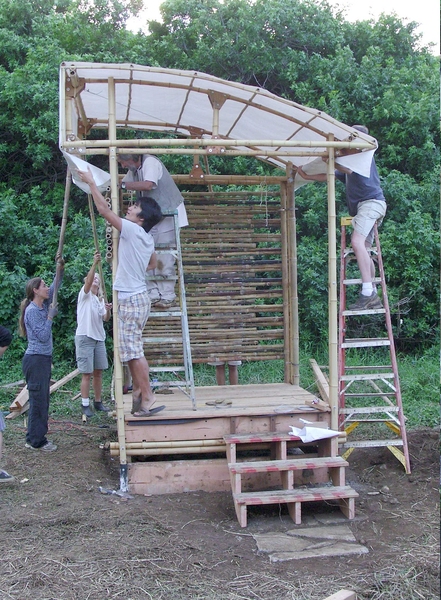Hawaii Island is caught in a Catch 22 situation.
Although the island boasts a fertile landscape that can easily support a broad range of agriculture, 85-90 percent of food consumed is imported from the mainland. High real estate costs have been partially responsible for perpetuating this dependency, prohibiting many young families from owning and farming the land as their parents did. Some locals have even left Hawaii in search of work.
As part of a larger effort to revitalize Hawaii's agricultural economy, MIT architecture students, led by Professor Jan Wampler, have partnered with the local non-profit Kohala Center and the Starseed Ranch to provide young farmers with land and housing.
Through a Public Service Center Service Learning grant, Wampler and the team developed and presented housing schemes to 65 community members this past January. Working on land donated by Starseed Ranch, the class designed and built a prototype that incorporates essential design elements such as a bamboo structure and solar panels. The dwellings are low cost, and primarily made of locally available materials. Units can be modified as households change, and farmers will have private homes and private yards near their farms.
The hands-on work and community collaboration have affected the students, including senior Amanda Levesque. “I've never seen a place in which the people and the land are so intertwined as they are in Hawaii. This experience has really driven home how great architecture revolves around the people who engage it and the land it extends from.”
Read more about the project on the Public Service Center web site.
Applications for sustainability-focused public service projects in Hawaii are now available.
Although the island boasts a fertile landscape that can easily support a broad range of agriculture, 85-90 percent of food consumed is imported from the mainland. High real estate costs have been partially responsible for perpetuating this dependency, prohibiting many young families from owning and farming the land as their parents did. Some locals have even left Hawaii in search of work.
As part of a larger effort to revitalize Hawaii's agricultural economy, MIT architecture students, led by Professor Jan Wampler, have partnered with the local non-profit Kohala Center and the Starseed Ranch to provide young farmers with land and housing.
Through a Public Service Center Service Learning grant, Wampler and the team developed and presented housing schemes to 65 community members this past January. Working on land donated by Starseed Ranch, the class designed and built a prototype that incorporates essential design elements such as a bamboo structure and solar panels. The dwellings are low cost, and primarily made of locally available materials. Units can be modified as households change, and farmers will have private homes and private yards near their farms.
The hands-on work and community collaboration have affected the students, including senior Amanda Levesque. “I've never seen a place in which the people and the land are so intertwined as they are in Hawaii. This experience has really driven home how great architecture revolves around the people who engage it and the land it extends from.”
Read more about the project on the Public Service Center web site.
Applications for sustainability-focused public service projects in Hawaii are now available.







